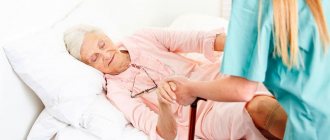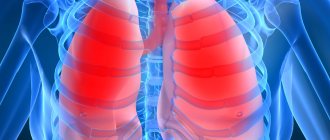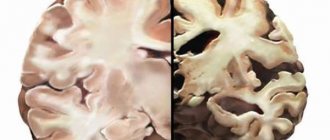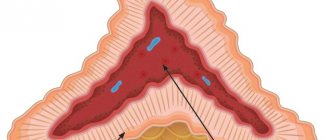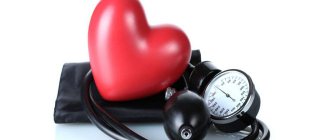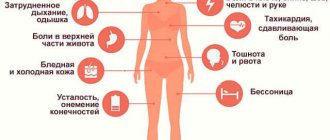Provoking factors
There are many reasons that cause numbness.
Such symptoms appear at different times at night, during sleep, during the day, and while working. Taking into account the frequency and duration of numbness, you can determine the presence of the disease. We list the main provoking factors:
- Prolonged stay in an uncomfortable position. This is often due to professional work.
- Prolonged exposure to cold.
- Bags with hard straps that put pressure on the skin.
- The hand is in a tense state for a long time.
- Scalenus syndrome, in which the artery under the collarbone and the branches of the brachial plexus are compressed. For this reason, numbness and pain occur.
- Problems with blood supply to the brain. This condition can be suspected when the patient suffers from hypertension and hypercholesterolemia. As a result, the movement of blood through the vessels becomes more difficult.
- Hypertensive disorder is complicated by several prizes.
- Carpal tunnel disorder occurs when the median nerve is compressed in the wrist area. The same type of hand movements can provoke this syndrome.
- Raynaud's syndrome. There are problems with arterial circulation in the small arteries in the arm. The main factor provoking this condition is poor heredity.
- Pathologies that provoke metabolic problems. Sensitive disorders develop according to the glove principle, when only the hand becomes numb.
- Polyneuropathy caused by a lack of B vitamins. In this case, numbness of the fingers on the right hand is often observed.
- Multiple sclerosis is diagnosed. In this situation, problems with sensitivity are accompanied by numbness and paresis.
- Stressful situations and prolonged depression.
- Adhesions and congestion provoke problems with blood flow. With such pathologies, the right hand goes numb at night. This occurs after pneumonia, uterine fibroids.
This is how a small number of pathologies and syndromes develop, when numbness is felt in the right hand, lengthy enumeration is needed. When a patient is bothered by prolonged numbness in the arm, they should consult a doctor.
Conclusion
With timely and adequate treatment, patients can be rehabilitated within 6-9 months. Regardless of how long the recovery takes, patients must adhere to certain recommendations throughout their lives:
- Monitor blood sugar and cholesterol levels;
- Change your diet (replace meat with fish, eliminate processed foods and baked goods, reduce salt intake);
- Be attentive to changes in your condition;
- Control urination, bowel movements and sleep duration;
- Continue taking medications to treat concomitant diseases.
When your limbs go numb
If both limbs on one side are numb, then most likely the cause is a stroke, transient ischemic attack, brain tumor or multiple sclerosis.
With a stroke, there are other symptoms: facial asymmetry, speech impairment, numbness of the limbs, muscle weakness. If you experience any of the above symptoms, you should immediately call an ambulance.
In a transient ischemic attack (TIA), a blood clot blocks a blood vessel in the brain for several minutes. This happens if the lumen is too narrow due to cholesterol plaques (atherosclerosis). Attacks occur regularly and are manifested by numbness of the arm, leg and/or face (mainly on one side), weakness, dizziness, double vision, and slow speech. The symptom complex depends on which vessel is affected.
Statistically, a third of people with a TIA will have a stroke, so such patients should definitely see a doctor to reduce their risks.
With multiple sclerosis, numbness of the face, limbs, and individual parts of the body is often the first symptom. Numbness can vary in strength, but sometimes it makes it significantly difficult to move an arm, leg, etc. There are no medications that can help cope with this condition. Despite the fact that the symptom may go away on its own, you should definitely seek help from a specialist as soon as possible.
Causes of hand sensitivity disorder
Numbness of the hands (paresthesia) is one of the symptoms of stroke (cerebrovascular accident). Impaired sensitivity of the limbs on one side of the body is accompanied by other focal, cerebral and autonomic symptoms. The cause of numbness in the hands after a stroke at a young age is inflammation of the vascular wall or blockage by a blood clot. In older age, hand numbness after a stroke is more often associated with atherosclerosis, arterial hypertension, diabetes mellitus, abdominal obesity, and smoking. Risk factors for stroke and hand paresthesia are smoking and alcohol. The genetic background for the development of cerebral ischemia is a predisposition to strokes in relatives.
When to see a doctor
In case of numbness, you should consult a doctor immediately if:
- numbness in the genital area and anus is accompanied by back pain and uncontrollable urination/defecation;
- the person’s consciousness is impaired to the point of loss of consciousness;
- numbness significantly complicates normal life;
- numbness appeared after a head, neck or back injury;
- numbness is accompanied by slow speech, vision problems, difficulty walking, or weakness;
- the entire limb became numb;
- numbness is accompanied by paralysis or weakness - it is impossible to move the limb;
- numbness is accompanied by a sudden and severe headache;
- significant numbness occurred suddenly.
If you have numbness, you should consult a doctor if:
- it is impossible to explain the cause of numbness;
- there is pain in the neck, forearm or fingers;
- the urge to urinate occurs more frequently;
- numbness in the legs increases when walking;
- a rash appeared;
- not only numbness occurred, but also dizziness, muscle spasms or other unusual symptoms;
- the numb area gradually increases in size;
- numbness is felt in the limbs on both sides.
How is the diagnosis made?
Usually, with numbness, a neurological examination and history taking will provide the doctor with a lot of information, and only then can a preliminary diagnosis be made. But for a final decision, it is often necessary to do an x-ray, magnetic resonance imaging, electromyography or blood tests.
Of course, there is no universal way to get rid of numbness, regardless of the cause of this condition. You need to act based on what exactly triggered the numbness. For example, a set of exercises often helps with carpal tunnel syndrome. If numbness is associated with diabetes, then you can only more carefully monitor your blood sugar levels. Vitamin B12 deficiency is corrected with therapeutic doses of appropriate medications.
Why can't you ignore numbness? The fact is that a person can damage a numb part of the body and not notice it. Therefore, even if there are no additional serious symptoms indicating a stroke or other serious condition, it is still worth contacting a neurologist with numbness.
How to recognize a stroke and what to do?
Early recognition of stroke determines the outcome of the disease. Admission of the patient to the hospital no later than 1.5 hours after the stroke will relieve numbness of the limbs and other severe symptoms. Therefore, everyone should know how to recognize the symptoms of a stroke. If a person suddenly becomes ill, do 3 tests:
- Ask the person to smile. If one half of the face is motionless and the corner of the mouth is drooping, a stroke is suspected.
- Ask them to raise both hands. If at the same time one arm drops, this is a sign of a stroke.
- Ask the person what his name is. If the patient slurs his words or does not understand the question, cerebral apoplexy is highly likely.
If at least one of the signs is detected, call an ambulance or take the victim to the hospital.
A short survey in 90% of cases makes it possible to diagnose a stroke and hospitalize the patient. The loss of time after the onset of a stroke is the loss of life!
Bibliography
- ICD-10 (International Classification of Diseases)
- Yusupov Hospital
- Batueva E.A., Kaygorodova N.B., Karakulova Yu.V. The influence of neurotrophic therapy on neuropathic pain and the psycho-vegetative status of patients with diabetic neuropathy // Russian Journal of Pain. 2011. No. 2. P. 46.
- Boyko A.N., Batysheva T.T., Kostenko E.V., Pivovarchik E.M., Ganzhula P.A., Ismailov A.M., Lisinker L.N., Khozova A.A., Otcheskaya O .V., Kamchatnov P.R. Neurodiclovit: possibility of use in patients with back pain // Farmateka. 2010. No. 7. pp. 63–68.
- Morozova O.G. Polyneuropathy in somatic practice // Internal medicine. 2007. No. 4 (4). pp. 37–39.
Prices for diagnosing the causes of numbness in the arms and legs
Situations arise when you need to consult a doctor for medical help immediately.
These symptoms include:
- The right hand goes numb, and coordination of movements becomes difficult.
- The hand constantly goes numb and the pain gets worse.
- The hand becomes numb, shortness of breath, weakness, and dizziness appear.
- The upper limbs become numb, problems with speech function appear.
- Temperature sensitivity worsens.
It should be borne in mind that all of the above symptoms may indicate serious conditions that complicate the health and threaten the lives of patients.
It is easier to prevent pathology than to treat its consequences later. For this purpose, you need to perform preventive procedures, maintain a healthy lifestyle, regulate your diet, and not be nervous.
When suspicious symptoms occur, you need to contact a specialist promptly. Only a doctor can determine the real cause of the disease and decide on a therapeutic method.
It is not common for the entire arm to go completely numb, but sometimes such symptoms appear in specific parts of the arm. When tingling occurs in the shoulders and fingers, among the causes are osteochondrosis in the neck and arthrosis. This often indicates a pre-stroke condition. When the fingers of the right hand go numb, especially at night, it means that problems arise with the functioning of the internal organs and respiratory tract.
Other causes of numbness
If the limbs on both sides are numb, then the spinal cord may be compressed due to a tumor, injury, hematoma, abscess (abscess), or it is a matter of peripheral polyneuropathy - damage to small peripheral nerves or disruption of their function. It is usually caused by certain medications, diabetes, chronic kidney disease, vitamin B12 deficiency, Lyme disease, or HIV infection.
Diabetic neuropathy is a fairly common occurrence in patients with diabetes. The exact cause of the damage is unknown, but it is believed that metabolic disorders and destruction of small vessels occur, which leads to nerve damage. If numbness has already occurred, it is impossible to completely get rid of it.
Exactly how vitamin B12 deficiency disrupts the formation of myelin sheaths on nerves is unknown. But if this substance is not enough, then the legs, rather than the arms, often go numb. Also, a lack of vitamin B12 is accompanied by anemia and weakness. But numbness occurs only with a very serious deficiency. With treatment, symptoms go away within 3 months; in severe cases, recovery can take a year.
When chronic kidney disease worsens, uremia occurs—products of nitrogen metabolism and other toxic substances accumulate in the blood. This leads to peripheral nerve damage and numbness. This condition (uremic polyneuropathy) is an indication for dialysis or kidney transplantation.
Lyme disease and HIV infection can cause inflammation of some parts of the nervous system. With Lyme disease, numbness does not appear immediately, but already against the background of a flu-like state, from which the disease begins. Lyme disease is treated with antibiotics.
With HIV infection, numbness often occurs due to the fact that a weakened immune system allows the development of a cytomegalovirus infection, which affects the nerve fibers. Numbness usually occurs in people who are not taking antiretroviral therapy, which can greatly improve the condition of a person with HIV. Therefore, in order for the numbness to go away, you need to start specific treatment as early as possible.
Why is osteochondrosis not on this list? The fact is that this diagnosis is not known anywhere except in the countries of the former Soviet Union. Usually they blame him for everything that they cannot explain. Degenerative changes in the spine are normal for anyone over 40 years of age. Numbness has other, real causes that can often be dealt with. Therefore, if you are diagnosed with osteochondrosis, you should consult another specialist.
The first signs of a stroke
FIRST SIGNS OF STROKE
(for the population)
Shcherbonosova Tatyana Anatolyevna
Head of the Department of Nervous Diseases and Psychiatry,
KGBOU DPO Institute for Advanced Training of Healthcare Specialists
Gorbulina Svetlana Vladimirovna
Assistant at the Department of Nervous Diseases and Psychiatry,
KGBOU DPO Institute for Advanced Training of Healthcare Specialists
Stroke is a sudden disruption of blood circulation in the brain, blockage or rupture of a cerebral vessel. When a blood vessel is blocked, an ischemic stroke occurs, and when a blood vessel ruptures, a hemorrhagic stroke occurs.
It is considered to be the most common brain disease in the adult population. Moreover, with age, the risk of stroke increases significantly. According to statistics, stroke affects 0.1 - 0.4% of the population per year, depending on the country of residence.
Stroke is the leading cause of human disability and ranks third among the causes of mortality.
Scientific research has proven that stroke primarily affects men, but the female half of humanity also suffers a lot from this disease. Therefore, everyone must know the first signs of a stroke in order to provide timely assistance to a sick person, because delay in this case is unacceptable.
Stroke is an acute disorder of cerebral circulation
Even before the active development of a stroke, the patient may show signs of a transient cerebral circulatory disorder.
Precursors of stroke:
– a person experiences a sudden and inexplicable headache. It does not appear due to stress or any other explainable reasons;
– dizziness appears, coordination of movements or balance is lost;
– some part of the body may become numb: tongue, face, arm or leg, torso. This phenomenon is present on one side of the body - on the right or left and is accompanied by weakness;
– vision suddenly deteriorates. The patient becomes unable to see with both one and two eyes;
– consciousness and orientation in the environment are disrupted;
– there may be a speech disorder.
The sensations described above appear suddenly and disappear after a few minutes or hours. And if such attacks are repeated regularly, then a person develops a stroke of varying severity within a year. There is no need to wait for everything to end soon; you should immediately call an ambulance.
Before the ambulance arrives, you need to do the following:
- calm the patient down and put him to bed. It is advisable for him to turn his head to the side. If a person is agitated, constantly coax him to calm down. Until doctors arrive, he cannot be moved to another place;
– Place a towel soaked in cold water on the head of the stroke victim. An ice pack or any frozen food will do;
– measure blood pressure. If it is high, you need to give the patient a drug that lowers blood pressure, but the drug should be the one that the patient usually takes;
– create access of fresh air into the room. It is necessary to immediately remove the patient from a stuffy, especially smoky room. Be sure to open the windows, unbutton clothes that restrict breathing - you need as much air as possible.
To check that these are signs of a stroke, you can perform a simple test: ask to smile, if half of the face remains motionless, this is a stroke.
Ask to keep your arms raised, if the muscles are weak, this will not be possible, ask to repeat a simple phrase, if you cannot repeat after you, then there are problems with articulation and this is an acute attack of circulatory disorders.
Ask the tongue to stick out - its tip deviates towards the lesion in the brain if there is a stroke. If such symptoms occur, it is an ischemic stroke, the symptoms of which are unambiguous and suggest a cerebral circulatory disorder.
The sooner emergency medical care is provided, the more favorable the prognosis for such a serious illness will be. It is optimal if you seek help within 2-3 hours after the onset of the attack.
The difference between stroke and its causes in women and stroke in men.
Stroke affects women mainly after 60 years of age, while in men the risk appears after 40 years of age. Previously, it was believed that stroke was a problem for older people and that stroke affected women less frequently than men, and that after 60 years of age the risk was the same for both men and women. However, between the ages of 18 and 40, strokes began to occur more often in women than in men.
Pregnant women are also more likely to have a stroke. Young women often ignore the symptoms of transient ischemia. Women suffer strokes more severely than men. The mortality rate from stroke is higher in women than in men. A smaller percentage of women are able to return to their previous rhythm of life after a stroke; men cope better with this.
“Unconventional” early signs of stroke may be more common in women than in men. To the well-known risk factors in women are added: taking oral contraceptives, pathological pregnancy, migraine pain; women have a higher predisposition to thrombosis and vascular complications.
Women who have frequent mood swings, are not stress-resistant, are not balanced, and have a tendency to dwell on problems are more susceptible to cerebral stroke. Women who smoke after age 30 and take birth control have a 22 percent increased risk of stroke.
In recent decades, there have been very frequent cases of severe ischemic strokes associated with the popularity of such a method of contraception as oral contraceptives.
Signs of stroke in women.
Symptoms of the disease, both in women and men, will primarily depend on the part of the brain that is attacked by the disease. If the right side of the brain is affected, then the symptoms of the disease appear in the left half of the body and, conversely, if the left side of the brain is affected, changes are felt in the organs that are on the right.
The main symptoms of stroke in women are as follows:
– unbearable headache without good reason;
– the face begins to go numb, there is weakness of the facial muscles;
– the leg and arm go numb on one side of the body;
– the woman is unable to gesture;
– speech is impaired, the patient cannot say a word or speaks indistinctly, and she also cannot understand what is being said to her;
– vision is impaired, up to its loss, this is especially true for one eye. May see double;
– coordination of movements is impaired;
– there may be a sudden loss of balance, cramps appear in the legs, arms or other half of the body;
– the patient may fall, as unexplained dizziness appears;
– with a stroke, depression may develop and the woman cannot control her emotions – she cries or laughs for no reason;
– nausea appears, even vomiting, hiccups, temperature rises, swallowing functions are impaired;
– there may be loss of consciousness for a short period of time. Before this, the woman’s face becomes red, she begins to breathe frequently and deeply, her pulse drops, and her pupils stop responding to light.
Signs of stroke in men.
The main symptoms of the disease in males are almost the same as in women and include:
– unbearable sudden headache, which is accompanied by dizziness;
– a sharp weakness appears that cannot be explained by anything;
– the part of the body affected by the disease begins to go numb. If the stroke is left-sided, then pain and numbness are felt on the right side of the body, and if the disease affects the right side, then numbness and pain are present on the left;
– there may be visual impairment and speech disorder;
– very often there are convulsions, nausea leading to vomiting, increased body temperature, loss of consciousness and even coma.
Experts also identified atypical symptoms. These include dry mouth, chest pain, and mental disorders. Individually, they do not cause suspicion of apoplexy, but in combination with typical ones they provide serious reasons for immediately contacting a doctor.
Symptoms of hemorrhagic stroke in young people.
This disease affects not only older people; it also develops in young people. This is affected by the rupture of a cerebral vessel aneurysm; this phenomenon is most often observed at a young age.
A hemorrhage occurs in the lining of the brain and a headache appears so severe that the person screams from unbearable pain. Then vomiting and loss of consciousness begin, but then the patient regains consciousness.
Such patients feel constant drowsiness and lethargy, which does not leave them for several days in a row, with a severe headache, vomiting is possible, but there is no paralysis.
Proper nutrition and a healthy lifestyle can help prevent strokes
Not a single person on the planet is immune from terrible diseases or premature death. But everyone has the opportunity to prevent disaster. In the case of stroke in women, especially young women, experts recommend adhering to the following recommendations. Some of these helpful tips will help prevent stroke not only in women, but also in men of any age:
– reduce the consumption of salty and fatty foods;
– refrain from smoking and simultaneously taking hormonal contraceptives;
– in case of diabetes mellitus, it is necessary to carefully monitor blood sugar levels;
– do not abuse alcohol and energy drinks;
– play sports or do exercises daily;
- monitor your sleep patterns - lack of sleep can also lead to impaired blood circulation in the vessels of the brain;
– monitor your weight – extra pounds push the body towards many diseases;
– eat more fruits and drink more clean water.
Fragment of the article “Lie down or be treated”,
"Russian newspaper"
dated April 23, 2020, No. 86 (6657)
Source: https://zdrav.khv.gov.ru/node/3884
The right arm is numb from the shoulder to the hand: what to do
If your right arm cramps severely and frequently, you should consult a doctor. To identify the cause, the doctor will prescribe an examination, which may include both laboratory and instrumental diagnostic methods. Once the underlying disease is identified, appropriate treatment is prescribed.
Which specialist to contact when a symptom occurs depends on several factors - additional symptoms, medical history, concomitant pathology.
- if numbness is the only symptom – see a neurologist;
- for pain in the spine - see a neurologist;
- after a joint injury - see a traumatologist;
- If you are additionally concerned about chest pain or have heart problems, see a cardiologist.
It is not always easy to determine which doctor you need to see. If you have doubts or it is not clear what disease the numbness is a symptom of, it is better to consult a general practitioner or family doctor. A general practitioner will examine the patient and, if necessary, refer him to a doctor with a narrower profile (neurologist, surgeon, cardiologist). If you suspect a myocardial infarction or stroke, you should immediately call an ambulance.
If there is reason to suspect a vascular accident (heart attack, stroke), you should call an ambulance
If your hand goes numb, you should not take medications on your own. Treatment depends on the primary disease that led to the development of the symptom. It is selected individually; there are no universal medications to get rid of paresthesia.
You can try to get rid of numbness at home. To do this, you must adhere to the following recommendations:
- If numbness occurs due to professional activity, you should take a break every hour and stretch your arm.
- Avoid wearing tight clothing that puts pressure on your neck or shoulders.
- If your right hand goes numb in your sleep, you need to change your position. A light hand massage will also help.
- For frequent numbness, exercises for flexion and extension of the hand, elbow and shoulder joint will help.
These recommendations may help if numbness occurs due to short-term pinching of a nerve or compression of a vessel.
When not the whole hand goes numb, but only the fingers, pathological processes appear. Let's list the main ones:
- Problems with blood supply to the brain. Patients with hypercholesterolemia and hypertension require special care.
- Elbow or shoulder injuries. An accompanying symptom is swelling in the tissues.
- Prolonged neuropsychological tension, stressful state.
- Osteochondrosis of the neck, disc herniation. After such diseases, pinching of the nerve fibers leading to the right hand occurs.
When numbness is felt in the hands, it means that pathological transformations of blood vessels or nerve endings are present. Therefore, it is necessary to contact specialists as soon as possible. Sometimes numbness occurs only in the fingertips or in some of them.
Numbness of the hands after a stroke: symptoms and treatment
In the modern world, stroke occurs in almost every person over 50 years of age. The disease is mainly diagnosed by the degree to which movement of the paralyzed part of the body is reduced. Patients exhibit left- or right-sided numbness of the facial muscles, and swallowing is impaired.
If, after a stroke, symptoms such as distortion of facial features, the inability to raise both arms at the same time, pronounced tremors in the limbs, or difficulty smiling are revealed, then immediately call an ambulance.
Signs of a stroke
During a transient ischemic attack, the signs leading to a stroke are periodic, tremors and numbness occur, trembling in the upper and lower extremities, accompanied by severe pain in the head. After a stroke, the duration of symptoms gradually increases.
The following sensations arise:
- Slowly increasing numbness in the arms and legs.
- Speech function disorder.
- Tremor on the side of the paresis.
- Double images, loss of visual fields.
- Excessive sweating, redness of the facial skin.
- Violation of thought processes.
These symptoms may persist even after hospitalization for a month. This is influenced by the depth and extent of the brain stroke focus.
Reasons for decreased mobility
Sharp tremor and numbness in the body alarm everyone, especially if it concerns loved ones. Such reasons may be associated with the occurrence of a transient ischemic attack or the onset of an ischemic stroke, which the doctor determines by the following signs:
- Atherosclerosis of the cerebral arteries.
- Formation of blood clots in the bloodstream of the heart.
- Dilatation of the veins of the lower extremities, there is a possibility of fragmentation; separated growths on the blood vessels can enter the general bloodstream, preventing blood from moving normally along the vascular bed.
- Postoperative intervention in the area of the carotid artery or injuries of the cervical spine, as well as due to osteochondrosis.
- Instability in blood pressure readings.
- High thrombus formation.
The role of exercise therapy classes
As a result of a stroke, the consequences can be unpredictable. During this very period, not only speech disturbances and decreased mental functions can be observed, but also tremors during movements. There is no likelihood that the patient, without receiving additional help, will be able to independently restore the functions he lost before the illness.
Therefore, during treatment, the use of drugs to reduce coagulation, control blood pressure, including physical exercises that improve the mobility of the joints of the arms and legs, becomes important for many patients. Do not begin exercises without consulting a physical therapist. After all, tremors and numbness in the hands manifest themselves differently in everyone.
After a stroke, the victim may feel his left or right hand shaking for a long time. Including slight numbness in the hands and tremors in the legs when moving.
To reduce paresis on the paralyzed side of the body, exercises are not contraindicated for patients in a coma. They should not be too intense, but take place in a more passive form. Exercise helps eliminate bedsores and atrophy of the lower extremities.
Rehabilitation
A person after a stroke needs constant help from the medical team and loved ones.
Knowing the characteristics of the course of a stroke, start with the simplest and most uncomplicated activities. For example, flexion and extension of the arms and legs at the joints up, down, counterclockwise, and in the opposite direction.
It is worth considering that if there is excessive numbness of the hands, accompanied by pain when moving, then physical exercise should be reduced or changed to less active ones.
It is necessary to constantly praise the victim for the task he performed, even minor movements of the fingers.
After restoring some movements, one should not assume that the patient will independently perform the exercises indicated to him.
Therefore, in order for the numbness of the hands to begin to be felt in a less pronounced form, the patient must perform any exercises within his power every day during the subsequent years of rehabilitation.
Traditional methods
No treatment method can lead to a 100% guarantee that paresis will be cured and subsequently recur. Therefore, it is worth remembering that there will always be consequences.
First of all, when prescribing medications, doctors may recommend rubbing an infusion of 2 tbsp to increase sensitivity. l laurel with vegetable oil. Tremor and numbness in the body, arms and legs after such a procedure are expressed to a lesser extent.
If you drink linden tincture before eating, you can prevent paresis and increase the restoration of movements in the arms and legs.
A mixture of medicinal herbs Adonis vernacular, Cinquefoil anserina and common thyme helps reduce paresis and help restore blood flow in the affected limbs.
Unrefined oil and garlic infused with an oil base, when taken three times a day, 10 ml of the drug within 24 hours, helps eliminate many of the consequences of a stroke. It is also useful for restoring movements due to the cleansing properties of garlic cloves.
Thumb
What happens when the thumb on the right hand goes numb? Symptoms are often caused by carpal tunnel syndrome. It manifests itself with prolonged stress on the wrist joint, which causes pinching of the wrist and cardiac nerve. It is undesirable to ignore such a condition, since muscle tissue atrophy manifests itself. When numbness does not last longer than an hour, you need to consult a doctor.
When the thumbs go numb at the same time on the hands, it means that the vertebrae in the cervical region have shifted. In this case, weakness and pain occur in numb fingers.
Main causes of numbness
1) Herniated intervertebral disc. Our spine is formed by bones (vertebrae) that sit on top of each other. It consists of five sections: cervical (7 vertebrae), thoracic (12 vertebrae), lumbar (5 vertebrae), as well as the sacrum and coccyx. Between each pair of vertebrae there is an intervertebral disc that absorbs friction between the vertebrae.
The intervertebral disc consists of two parts: a fibrous membrane or annulus fibrosus and a gel-like content (nucleus pulposus). When the hard outer shell is damaged, part of the nucleus pulposus can come out and begin to compress a nearby nerve root, leading to pain and other unpleasant symptoms, including numbness and tingling in the extremities.
In severe cases, a patient with a herniated disc may require surgery.
Symptoms of a herniated disc depend on its location and size. Most often, intervertebral hernias occur in the lumbar spine, since it is quite mobile and is forced to bear the weight of our entire body. The cervical spine is also prone to the formation of intervertebral hernias.
Most rarely, intervertebral hernias develop in the thoracic region. The sacrum and coccyx are solid bones and do not contain intervertebral discs. If an intervertebral hernia has formed in the cervical region, then its symptoms will spread to the neck and upper limbs. A thoracic disc herniation causes pain, numbness, and tingling in the thoracic spine and torso. A lumbar hernia causes pain in the lower back and lower extremities, including the buttocks and hips, legs and feet.
Bibliography
- ICD-10 (International Classification of Diseases)
- Yusupov Hospital
- Batueva E.A., Kaygorodova N.B., Karakulova Yu.V. The influence of neurotrophic therapy on neuropathic pain and the psycho-vegetative status of patients with diabetic neuropathy // Russian Journal of Pain. 2011. No. 2. P. 46.
- Boyko A.N., Batysheva T.T., Kostenko E.V., Pivovarchik E.M., Ganzhula P.A., Ismailov A.M., Lisinker L.N., Khozova A.A., Otcheskaya O .V., Kamchatnov P.R. Neurodiclovit: possibility of use in patients with back pain // Farmateka. 2010. No. 7. pp. 63–68.
- Morozova O.G. Polyneuropathy in somatic practice // Internal medicine. 2007. No. 4 (4). pp. 37–39.
Numbness during pregnancy
Sensitivity in the arms and legs during pregnancy is eliminated as a result of excessive compression of excess fluid that collects in the tissues and affects the nerve fibers. At night the swelling intensifies, so the right upper arm goes numb more often during sleep. To prevent this unpleasant symptom, you need to perform physical activity that stimulates blood circulation. Other recommendations to help prevent numbness in your limbs:
- It is advisable to select nightwear without elastic bands that squeeze your hands.
- Before going to bed, you should regularly perform massage treatments on your shoulders and hands.
- It is not advisable to overload your limbs during the day.
Stroke
STROKE (apoplexy)
- acute cerebrovascular accident with damage to brain tissue and disruption of its functions.
The main causes of stroke are hypertension and cerebral atherosclerosis. Stroke can also occur with other vascular diseases, rheumatism, blood diseases, etc. There are hemorrhagic strokes
.
in which bleeding in the brain occurs, and ischemic stroke
. arising as a result of difficulty or interruption of blood flow to one or another part of the brain and accompanied by softening of a section of brain tissue - cerebral infarction. Although in most patients a stroke occurs suddenly, it is often preceded by so-called precursors. For example, with hypertension and atherosclerosis, noise and heaviness in the head, headache and dizziness increase.
Hemorrhagic stroke most often occurs during the day. The patient experiences paresis (paralysis) of the arms and legs, usually on one side (for example, the right arm and leg with hemorrhage in the left hemisphere of the brain), and speech is impaired. Many patients lose consciousness and do not react to their surroundings; in the first hours there are breathing problems, convulsions and vomiting.
An ischemic stroke can occur at any time of the day, sometimes it develops gradually. For example, first the hand goes numb, then half of the cheek, and then speech is impaired. In general, the manifestations of a stroke are caused by the localization of hemorrhage or cerebral infarction, which leads to disruption of the corresponding brain functions.
It is advisable to treat stroke in a neurological hospital. At home, it is often difficult to conduct the necessary research, provide care for the patient, and prevent complications. As a rule, almost any patient can be transported to the hospital (by ambulance), with the exception of cases where the stroke is complicated, for example, by cardiac and respiratory disorders. In the first hours, it is important to establish the correct diagnosis and the nature of the disease, since the treatment of patients with ischemic and hemorrhagic stroke is different. Of great importance are spinal puncture with examination of cerebrospinal fluid, examination of the fundus, echoencephalography, etc. In some cases, patients require special examination and treatment in a neurosurgical department.
After a stroke, patients may experience various motor dysfunctions (paralysis, paresis), speech disorders, sensitivity, and urination disorders for a more or less long time.
Recovery of impaired functions (movement, speech, etc.) after a stroke often occurs slowly and may not be complete by the time of discharge from the hospital. Therefore, upon returning home, the patient needs special care. First of all, certain hygienic conditions must be strictly observed. The mattress on the patient’s bed should be smooth and soft, the sheets should be without folds. This helps prevent bedsores and other complications. If the patient uses a “duck” or a bedpan, then an oilcloth covered with a diaper is placed under them, which is easy to change after using the toilet. The patient is washed daily and general wiping is done with camphor alcohol or eau de toilette. When feeding a bedridden patient, raise his head or give him a semi-sitting position. Food should be easily digestible, and liquids should be given from a sippy cup or through a plastic tube.
If after discharge from the hospital the patient remains on bed rest, you need to monitor his correct position in bed. When he lies on his back, a stool is placed next to the bed on the side of the paralyzed arm and a large pillow is placed on it, its corner should be under the shoulder joint. The arm is extended at the elbow joint, and a splint cut from plywood and reaching to the middle of the forearm is applied to the hand from the palmar surface with the fingers spread and straightened. It is wrapped in cotton wool and a bandage, and then another bandage is attached to the hand and forearm. The extended arm is turned palm up, moved to the side at an angle of 90° and placed on a pillow so that the shoulder joint and the entire arm are at the same level, in a horizontal plane. This prevents the development of stiffness and pain in the shoulder joint. A roll of gauze and cotton wool is placed between the arm and the chest. To maintain the given position of the hand, a bag of sand weighing half a kilogram is placed on it.
The paralyzed leg is bent at the knee joint by 15-20°, and a pad of cotton wool and gauze is placed under the knee. The foot is bent at an angle of 90° and held in this position using a special device (a box covered with quilted padding, some kind of case, etc.), into which the patient rests with the sole.
Thus, in the position of the patient on his back, the paralyzed arm and leg are predominantly in a semi-extended position. When the patient lies on his healthy side, the paralyzed limbs are given a different position. The arm is bent at the shoulder and elbow joints and a pillow is placed under it, the leg is also bent at the hip, knee and ankle joints and also placed on a pillow.
The patient should be turned from back to side and vice versa and placed in the recommended positions every l.5-2 hours. During meals, therapeutic exercises and massage, as well as afternoon rest and night sleep, there is no need to give the arm and leg a special position.
Regardless of the degree of residual movement disorder, therapeutic exercises are prescribed on the recommendation of the attending physician. A bedridden patient is taught to sit down correctly. Those who can sit up in bed independently should be taught to transfer to a chair or wheelchair next to the bed. A patient who can stand up is taught to walk correctly - first with the help of a special stick (“tragus” with four legs), then with an ordinary stick and, finally, without a stick.
All activities to activate the patient at home (learning to sit, walk) are carried out under the supervision of a health worker. The program of therapeutic exercises is compiled by a neurologist and a physical therapy methodologist. For speech disorders, speech therapy classes are conducted according to a special program. As a rule, speech restoration classes and therapeutic exercises begin in a hospital, and then continue at home and, finally, on an outpatient basis. For mild residual effects of a stroke, sanatorium treatment is recommended, preferably in familiar climatic conditions.
Expert advice
First of all, you need:
- Move more often, walk, do not take the elevator.
- Remember about exercises, increase physical activity through dancing.
- Stop smoking to strengthen the vascular walls.
- Eat more vegetables and fruits.
- Don't be nervous, stop worrying.
There is no such thing as being too concerned about your own health.
Head of the Research Center for Motor Neuron Disease/ALS, Candidate of Medical Sciences, doctor of the highest category
neurologist, candidate of medical sciences
Head of the Department of Rehabilitation Medicine, Physiotherapy Physician, Neurologist, Reflexologist
Doctor – neurologist, leading specialist of the neurology department
Neurologist, Candidate of Medical Sciences
Your hand goes numb in your sleep
Deterioration in the sensitivity of the right hand during sleep may occur due to an uncomfortable pillow or posture. Numbness often occurs because a person is used to placing their hands under their heads or hugging pillows. To get rid of numbness, you need to take a different position or choose a more comfortable pillow.
The nerve processes are pinched by tendons or muscle tissue when osteochondrosis develops in the neck or a tunnel form of neuropathy.
- Endocrine system disorders.
- Severe hormonal disorders.
- Hand injuries.
- Problems with blood vessels.
Traditional medicine
Numbness after a stroke leads to periodic tremors. If pathology is detected on the left side of the head, then the right leg and arm are paralyzed. And vice versa.
To save the patient, the doctor prescribes anticonvulsants, for example, Finlepsin or Carbamazepine 200 mg per day.
It is important to be careful: you should not allow the dose of Finlepsin to increase; there is a danger of causing bone fragility due to leaching of calcium from the body. The drug Carbamazepine is addictive, if there is little benefit and the doctor may write a prescription for Topiramate, Levitaratsitam or Gabapentin instead of this medicine.
Read also: Stroke at work
Therapy
Medicines that increase blood circulation, medicines that have an anti-inflammatory effect.
Vitamin complexes determined taking into account the individual characteristics of the patient’s body. Doctors independently determine the course of treatment.
- Physiotherapeutic techniques.
- Gymnastic exercises.
- Dietary diet.
- Reflexology.
When the right hand goes numb, when the nerve fiber is pinched, manual manipulation can be used for therapeutic purposes. Prevention matters too. In winter, during cold weather, it is necessary to use gloves, not to get into prolonged stressful situations and not to be depressed, to play sports, and regularly perform various exercises that help strengthen the body and improve the quality of blood supply to certain parts of the body, including the right hand.
Mechanism of sensory impairment in cerebral ischemia
The brain regulates processes occurring in the body through neurohumoral pathways. Each part of the brain is responsible for a specific function: motor, sensory, visual and auditory. After blood flow is disrupted in the corresponding part of the brain, neurons die, and as a result, its function is lost. After damage to the center of the brain responsible for the sensory function of the arms and legs, paresthesia of the limbs appears.
Cerebral ischemia occurs for the following reasons:
- prolonged vascular spasm in atherosclerosis;
- blockage of a cerebral vessel by a thrombus;
- blockage of a cerebral vessel by a thrombus brought with blood flow from the cavity of the heart, aorta or large vessels;
- hemorrhage in the brain or subarachnoid space (secondary ischemia).
In some cases, the atherosclerotic plaque itself blocks the lumen of the vessel, resulting in ischemia with the occurrence of paresthesia of the extremities. In some cases, the formation of a blood clot occurs at the site of an atherosclerotic plaque in the cerebral vessels. With arrhythmia, a blood clot forms in the cavity of the heart, and then travels through the bloodstream into the vessels of the brain and causes a blockage. Blood clots formed in the aorta and carotid artery sometimes break off and enter the brain vessel. If the sensory area of the brain is damaged due to blockage, sensitivity is impaired, numbness of the arms and legs on one side of the body occurs.
Numbness of the limbs often occurs during a hypertensive crisis or diabetes mellitus. In this case, transient cerebral ischemia develops. It lasts from 2 minutes to 24 hours. At the onset of a cerebral stroke, it is clinically impossible to determine what kind of ischemia it is. If ischemia progresses after 24 hours, it is diagnosed as a stroke. Ischemia that stopped before 24 hours is regarded as transient (transitory).
Exercises
It is recommended to perform therapeutic exercises every day for 2 approaches for about 3-4 weeks. Exercises require caution; it is not advisable to allow severe pain to occur. Moderate tolerable symptoms caused by tendon stretching when performing such exercises are inevitable. At the same time, it is better to do everything rationally.
A gradual increase in muscle load and joint mobility is required. It should be borne in mind that if gymnastics is performed correctly, improvements occur gradually. Within 2 weeks of training, the pain gets worse, after 3-4 weeks you can feel the first symptoms of improvement.
A symptom that is insignificant at first glance requires attention, since problems with blood supply and innervation cause atrophy of muscle tissue and deterioration of sensitivity, indicating irreversible processes that are eliminated in the first stages of development.
Let's figure out when it is undesirable to perform therapeutic exercises:
- If your wrist has been recently injured.
- Arthritis (with stable remission, procedures are permitted).
- Heat.
- Flu, acute respiratory infections, sore throat. Gymnastics is allowed 3-4 days after recovery.
- Minimum 3 months after surgery.
If you experience sudden pain during exercise, you should stop doing it.
Prevention
To prevent disorders of the cervical spine and improve blood circulation in the right limb, you can use specially designed exercises:
- You need to sit on a chair, grab your shoulders with your hands and move your joints in a circle with successive repetitions 10-15 times.
- You need to cross your fingers on your right and left hands, bring them to the back of your head. The elbows are kept at the same level, the joints are brought together and straightened to the sides about 15 times.
- You need to take a vertical position, place your legs at shoulder level, and place your hands on your hips. You need to turn your body left and right 10 times.
- The arms rise upward as you inhale, then gradually lower as you exhale.
- The starting position is the same. You need to turn your head, then tilt it towards your shoulders 10 times.
- You need to rotate your head clockwise, then in the opposite direction. It is better to perform the exercise in a sitting position, while monitoring your well-being.
- There is no need to walk in place, gradually raise your arms and hips.
- Hands rise up, straighten to the sides, then down and so on 10 times.
The duration of such gymnastics is about 10 minutes. If possible, you should perform exercises up to 3 times a day. Elementary exercises not only relieve numbness, but will also serve as an excellent prevention of neck osteochondrosis, and may also have a positive effect on the body.
What causes numbness and tingling?
There are many causes of numbness and tingling, including certain medications. Things we do every day can also cause numbness. These include: standing or sitting for long periods of time, sitting cross-legged, and sleeping on your arm. All this leads to impaired blood flow. Typically, numbness caused by insufficient blood supply goes away completely within a short time.
There are many conditions that can cause numbness, such as insect or animal bites, toxins found in certain seafood, certain medications, or radiation therapy. Abnormal levels of vitamin B12, potassium, calcium, or sodium may be other potential causes of paresthesia.
Most often, numbness can be a consequence of osteochondrosis of the spine and its complications, for example, with a herniated intervertebral disc, numbness will often be a distant symptom, and with a herniated cervical spine, a very characteristic symptom is numbness of the fingers. Nerve compression is one of the most common causes of numbness.
Numbness and tingling can be symptoms of certain medical conditions. These include: diabetes, Raynaud's phenomenon, multiple sclerosis, seizures, hardening of the arteries, or an underactive thyroid gland (hypothyroidism, Hashimoto's thyroiditis). A stroke or transient ischemic attack (mini-stroke) can also cause numbness and tingling.
Numbness can result from damage to the skin due to rash, inflammation or injury. Conditions that can lead to this type of damage include frostbite and shingles (a painful rash caused by the chickenpox virus).

